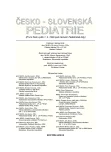The Screening and Brief Intervention Project in Primary Care Pediatric Surgeries with the Aim of Reducing Substance Abuse by Teenagers
Authors:
P. Kabíček 1,2; Š. Sulek 1,2; L. Mizerová 1; O. Starostová 3; L. Wenchich 1; L. Csémy 4; J. Knight 5
Authors‘ workplace:
Klinika dětského a dorostového lékařství 1. LF UK a VFN, Praha
přednosta prof. MUDr. J. Zeman, DrSc.
1; Subkatedra dorostového lékařství IPVZ, Praha
ředitel Mgr. et Mgr. R. Gabriel
2; Cepros (Centrum výzkumu protidrogových služeb a veřejného zdraví), Praha
vedoucí E. Čápová, DiS.
3; Psychiatrické centrum Praha, Praha – Bohnice
ředitel prof. MUDr. C. Höschl, DrSc., FRCPsych.
4; CeASAR – Center for Adolescent Substance Abuse Research, Harvard Medical School, Children´s Hospital, Boston, Massachusets, USA
Prof. J. Knight, MD, Ph. D.
5
Published in:
Čes-slov Pediat 2010; 65 (11): 654-659.
Category:
Review
Overview
Recent studies show that primary care pediatricians are in a unique position to provide individual counselling in the matter of risky behavior in young people. The best well-known approaches are those focused on the prevention of the abuse of addictive substances. The pediatrician has natural authority over adolescents and the counselling methods are easy to learn in a short time. The pediatrician can point out the negative health consequences of drug abuse. For the most part it is possible to engage in a preventive session alone with the adolescent, without the presence of his/her parents.
The CRAFFT questionnaire is a brief, prevention-focused, simple diagnostic tool used to estimate the extent and severity of drug abuse in children and adolescents. The CRAFFT result is a base for an adequate brief intervention.
The brief intervention can reduce the number of adolescents who abuse drugs as well as the health consequences of drug abuse.
Key words:
drugs, prevention, risky behavior syndrome in adolescence, adolescence, CRAFFT, brief intervention, confidentiality
Sources
1. ESPAD, Evropská školní studie o alkoholu a jiných drogách (European School Survey Project on Alcohol and other Drugs), http://www.espad.org.
2. Koutek J, Kocourková J. Sebevražedné chování. 1. vyd. Praha: Portál, 2007 : 24.
3. Machová J, Hamanová J. Reprodukční zdraví v dospívání. 1.vyd. Praha: H & H, 2002 : 142.
4. Ústav zdravotnických informací a statistiky ČR. Zdravotnická ročenka ČR 2006. http://www.uzis.cz.
5. Behrman RE, Kliegman RM, Jenson HB. Nelson Textbook of Pediatrics. 17th and 18th ed. Philadelphia, Pennsylvania. USA: Saunders, 2004 : 656; 2007 : 826.
6. Levy S, Sherritt L, Gabrielli J, Shrier LA, Knight JR. Screening adolescents for substance use-related high-risk sexual behaviors. J. Adolesc. Health 2009; 45 : 473–477.
7. Knight JR, Sheritt L, Shrier LA, et al. Validity of the CRAFFT substance abuse screening test adolescent clinic patients. Arch. Pediatr. Adolescent. Med. 2002; 156 : 607–614.
8. Kolektiv autorů. Manuál drogové prevence v praxi praktického lékaře pro děti a dorost. Praha: Cepros, 2006.
9. Csémy L, Knight JR, Starostová O, Sherrit L, Kabíček P, Van Hook S. Screening rizikového užívání návykových látek u dospívajících: zkušenosti s českou adaptací dotazníku CRAFFT. Vox Pediatriae 2008; 8 : 14–23.
10. Kabíček P, Hamanová J. Prevence rizikového chování v dospívání. Postgraduální Medicína 2005; 7, příloha č. 2 : 57–60.
11. Kabíček P, Jacobs P, Hamanová J, Frouzová M. Aktuální problematika dorostového lékařství, péče o dospívající ohrožené abúzem návykových látek. Postgraduální Medicína 2006; 8 : 156–161.
Labels
Neonatology Paediatrics General practitioner for children and adolescentsArticle was published in
Czech-Slovak Pediatrics

2010 Issue 11
Most read in this issue
- Henoch-Schönlein purpura – State-of-the-Art Diagnosis and Treatment
-
Hemolytic Uremic Syndrome (HUS) – One of the Most Common Causes of Acute Renal Failure in Childhood.
Complexity of the Pathophysiology and Novel Diagnostic and Therapeutic Options for Atypical Forms - Current Trends in the Treatment of Invagination in Childhood
- Imunoglukan P4H® in the Prevention of Recurrent Respiratory Infections in Childhood
